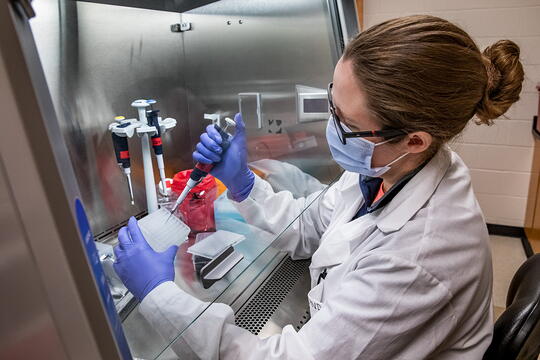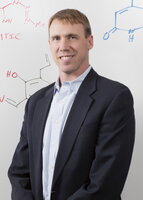
CHAMPAIGN, Ill. — In the fall of 2020, the University of Illinois Urbana-Champaign welcomed students back for in-person instruction amid the powerful first wave of the COVID-19 pandemic. The university successfully maintained operations throughout the semester – with zero COVID-19-related deaths or hospitalizations in the campus community – thanks to its “SHIELD: Target, Test, Tell” program.
In a sweeping report, the team behind the campuswide collaboration details the innovations in modeling, saliva testing and results reporting that helped mitigate the spread of the virus, and shares the data collected and lessons learned through the process. The paper appears in the journal Nature Communications.
“We were able to rally together and keep the university open safely. We stayed open, and we didn't cause increased deaths within our community, and therefore showed others that it was possible,” said SHIELD team member Dr. Martin D. Burke, a professor of chemistry at Illinois and a member of the Carle Illinois College of Medicine, as well as a medical doctor. “This is Illinois at its best. This paper hopefully will be a useful resource for other groups and communities to confidently play offense when it comes to the next pandemic.”
Comparing COVID-19 outcomes from July 6, 2020 to Dec. 23, 2020 in all 251 counties in the U.S. that host a large university, the number of COVID-19 cases in Champaign County, where the university is located, was roughly a third less than expected, the researchers report in the paper. Moreover, Champaign County had the greatest reduction in deaths – more than four times less than would be predicted based on other counties’ numbers.

“We don't know what would have happened in Champaign-Urbana if we didn't do this, but if we look at similar communities that have large universities, large student populations, we overperformed by a lot,” said epidemiologist Rebecca L. Smith, a professor in the College of Veterinary Medicine and SHIELD team member.
The center of the SHIELD program is a rapid-yet-sensitive, saliva-based test. Illinois chemists developed the test as an alternative to the invasive nasal swabs that were standard at the time. They found that by heating the samples, they could deactivate the virus and skip the step of extracting its genetic material – the most costly, supply-chain-taxing and time-consuming part of PCR testing. The testing protocol has now received emergency use authorization from the U.S. Food and Drug Administration and has been deployed in schools, organizations and communities throughout the nation through the University of Illinois System spinoff organizations SHIELD Illinois and Shield T3.
Several School of Molecular & Cellular Biology researchers were pivotal in developing the university's saliva test for COVID-19: Fadi G. Alnaji, postdoctoral researcher focusing on virology, Christopher Brooke, a professor of microbiology, and Diana Ranoa, a PhD graduate in microbiology and current postdoctoral researcher in the Paul Hergenrother lab.
“We deployed the test on a massive scale here, demonstrating that it was possible,” said chemistry professor Paul Hergenrother, who led the test development team. “We were processing almost 20,000 tests on some days. Now it’s been used around 15 million times worldwide.”

Illinois researchers developed a rapid saliva-based test, and results were confidentially shared via the Safer Illinois app. Campus community members were tested twice weekly to diagnose infections before symptoms appeared.
However, the university had to determine whom to test and how often. Based on early indicators that the virus can be spread through aerosols and by asymptomatic individuals, the “Target” arm of the program deployed extensive modeling that pointed to testing everyone on campus twice a week as the optimal way to detect infections before they became symptomatic. The vast amounts of real-time data generated by the widescale testing allowed the researchers to update their models and campus leaders to adjust procedures as time went on.
“The predictions of models changed as new trends emerged, so it was essential that we had real-time data to give the right input to policymakers in public health and the campus,” said physics professor and SHIELD team member Nigel Goldenfeld. “For example, those with high levels of social activity have more opportunity to transmit COVID, and by using our real-time data analysis, we could identify the locations where excess transmission was occurring and test those people more frequently.”
Rapid, large-scale testing also requires fast and confidential reporting of test results – the “Tell” portion of the program. Working closely with the Champaign-Urbana Public Health District, campus engineers and designers developed a smartphone app, Safer Illinois, to deliver test results, notify of possible exposures and facilitate communication.
The university also implemented a policy that required each person to provide evidence of their negative test status via the app or a web portal to gain access to campus buildings, which encouraged compliance.
“The Safer Illinois app provided users personalized testing results and reminders of their scheduled testing, along with a display of their current testing status, all without showing any personalized health information to personnel assigned to university building entrances,” said landscape architecture professor and SHIELD team member William Sullivan, who led the team that developed the app.
“We tried to lower as many barriers as possible,” said veterinary clinical medicine professor Timothy Fan, who oversaw the diagnostic lab. “And many of those were just practical – eliminating supply chain bottlenecks, the ease of giving saliva samples, having the app right at your fingertips – so that really allowed us to be successful.”
One crucial finding that emerged from the data was that the infection rate among undergraduate students was completely unrelated to the infection rate in surrounding Champaign County, indicating that outbreaks at the university did not spread to the community.
“We saw that cases among undergrads followed a regular pattern with the academic calendar, rather than county and statewide trends, and didn't spill over into the surrounding community. Preliminary analysis of the data from subsequent semesters and variants hold to that pattern as well. The adaptive layered mitigation has proved to be robust and generalizable,” said civil and environmental engineering professor and SHIELD team member Ahmed Elbanna.
“That’s why we called it SHIELD – the entire program was designed to achieve the protection, to both our campus and surrounding community, that we saw in our data,” Burke said.





